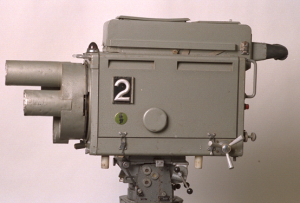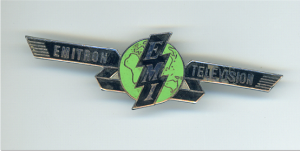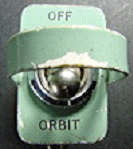Alex Thomas
I was sent to Wood Norton in March 1960 to join PTO 7. I had spent the winter of 1959/60 in Telecine at Lime Grove and occasionally at Riverside Studios as a Technical Operator.
At the end of the day’s transmission, around 23:30, we would lace up a short film into a Cintel TK machine which had been converted to 625 line send the output to Crystal Palace. The picture on a 625 line monitor was superb but when I arrived at Wood Norton, the perceived wisdom was that 405 line pictures were better than 625 and, despite my protests, I was told that if I claimed the “truth” I would fail my end of term exam and be looking for another job.
I did 40 years with Auntie so I supported the status quo.
Hugh Sheppard
As to 405 line/625 line picture quality, it was true that on a 12 inch set 405 came over well as it appeared to have better contrast, but gradually it dawned that this was because it lacked texture.
Alec Bray
The received wisdom in 1963 was that the CPS Emtirons (at this time, only found in Lime Grove) gave a better rendition of the facial tones than did the Image Orthicons in TVC.
Bob Auger
Re the 405/625 picture quality debate, surely it was the superior grey scale and lower noise that made the 405 CPS Emitron cameras look better than the grainy and contrasty 625-line Image Orthicons. They were still in service at Lime Grove when I joined on TO22 in 1965. The CPS Emitrons were definitely not the most ergonomic of devices and "peel" was a dramatic downside. Pictures were still good for their day, though, probably the last great EMI camera.
Arthur Pullinger at EMI told me they had a three-tube 1000 line CPS Emitron colour camera in the lab at Hayes that looked superb but it never went into production.
Geoff Fletcher
Remember the dreaded "peel" on CPS Emitrons? And the left handed focus knob? And the wrist disclocating lens change system? And the C spanners to plug them up to the wall points in Lime Grove? And the skinned knuckles when you caught them on the protruding screw heads at the wall socket? I still have an EMI side logo plate I liberated when they were taken out of service
Bill Jenkin
The focus knob on the later CPS Emitrons moved both the lens turret and the tube. An earlier 3 lens turret version only moved the tube.
I remember the focus on the Marconi BD 848, the three tube 3” image orthicon colour cameras which were used in Studio H for a while, focussed by moving the turret. As you pulled focus, which I think was done by twisting the panning handle, the picture shifted sideways for each twist.
Image Orthicons
Chris Woolf
Image Orthicons were prone to image "stick", particularly as they aged. Orbiting the image – I think both motor drives and electrical scan orbiting were used on different designs – prevented this.
Cameramen were supposed to turn orbiting off during Transmission but leave it on during rehearsals.
Alec Bray
All the 4.5 inch IOs that I used – Marconi Mk 4. EMI 203 and Pye Mk V all used electomagnetic scan orbiting – the scans were varied slightly vertically and horizontally so that the image was slowly moved around in a circular path across the image area of the tube (after the image intensifier bit of the tube). Usually part of the line up procedure involved making sure that Orbit was turned off – it was a cameraman responsibility – but there were some programmes which went out with at least one camera on orbit …
Alan Stokes
Yes, I got caught out on a “Blue Peter”. Even more reasons for getting on to Sound ASAP!
Ian Hillson, John Howell
My very first attempt at manning a camera (apart from the microscope attachment) was one closing caption.
I won’t assert that my mentor deliberately didn’t tell me about Orbit but he was grinning a lot. There were very few controls on the back panel of an EMI 203 IO camera and the orbit switch was one of them.
My mentor described an IO camera CCU as being covered in knobs – "any or all of which made the picture slightly worse".
Barry Bonner
The image was rotated using motorised potentiometers which slightly changed the scan coils’ magnetic fields: this I learnt before defecting to the sound department!
Geoff Fletcher, Bill Jenkins, Hugh Sheppard
I well remember Racks coming through on cans with "Have you got your orbit on 5?" (Or whatever number camera you were on). It was easy to forget it was on. The movement was quite easy to spot on captions however.
And of course come the Transmission or Recording it stuck anyway, especially on word captions. Then you were left with a word burned on the tube which you had to hastily get rid of by pointing defocused at a light. And then Bryan Cowgill would shout at you "Focus up 4" or whatever you were on…. (and that was the polite version).
Chris Harnett
I can remember the EMI 201 orbit facility well, it was horribly obvious on the opening captions of a Transmission or Recording when the poor s*d on camera 4 (Cardiff A, Broadway ) had left it on as the operator performed a rotating dance movement as he tried to compensate on his caption and it used to cause suppressed laughter almost audible as the music cross faded to the studio sound.
Chris Wickham
Previously there had been "Overscan" for rehearsal, the problem here being that when the camera was switched to normal scans effectively all the lenses (then, very few zooms) became tighter.
Alec Bray
The EMI 203’s in TC4 and TC5 suffered a great deal from Microphony. Initially I used to get Racks on talkback to sort it out, but after a while I became expert in the DIY repair department. The “repair” consisted of hitting the side of the camera – about one third of the way along from the viewfinder and about two inches down – with a sharp rap from the knuckle of one finger: percussive maintenance – problem sorted!
Rex Palmer and Dave Plowman
The EMI 2001 Colour Camera was one of the all time great designs.
The two features that made it so good were the presence of a fourth, ‘luminance’, tube and the fact that the zoom lens was fitted within the body of the camera making it quite compact. It was, thus, ideally suited to both studio and OB use.
Hugh Sheppard
When EMI turned up with the 2001, didn’t they have just one day to spare in the race to provide the BBC’s first studio colour cameras? That was the story emanating from Pres B. during the trials.
David Hunter
I met the man responsible for the physical design of the 2001 on a visit to EMI sometime in the 1970’s. Apparently the colour splitting block which made the layout of the camera possible was originally designed and made for a medical device at a time when EMI were unsure whether they wanted to continue in the TV camera market. Looking for other uses for the expensive block, someone realised it could form the basis for a camera. My informant was a weapons system designer who had had no previous involvement with camera design: "I didn’t have a lot of time for research, so I just treated it as if it was an anti-aircraft gun. Seems to have worked!"
Patrick Heigham
I hear horrendous stories of electronic HD cameras, which have fans to keep the circuitry cool. Our sound mixers have a terrible time trying to get useable dialogue because of this.
I gather that the RED camera is the worst offender, and with the propensity of multi-camera shoots, the problem becomes magnified. And 3D doubles the cameras, instantly.
35mm Motion picture film cameras were designed with blimps, mostly effective – Panavision were fine but the Arri 35’s were a bit naughty.
Another interesting spin-off – because of no film, requiring re-loads every 10 mins (1000ft mags), Directors can run scenes for ever! Boom Ops wilt, holding poles, so surprise, surprise, the dolly boom may well come back into play – but how many of our younger people can operate such?
Alasdair Lawrance:
Someone asked, "How do you convince everyone on set that video is as good as film?"
The reply was: "Put a clapper board on each take…"






